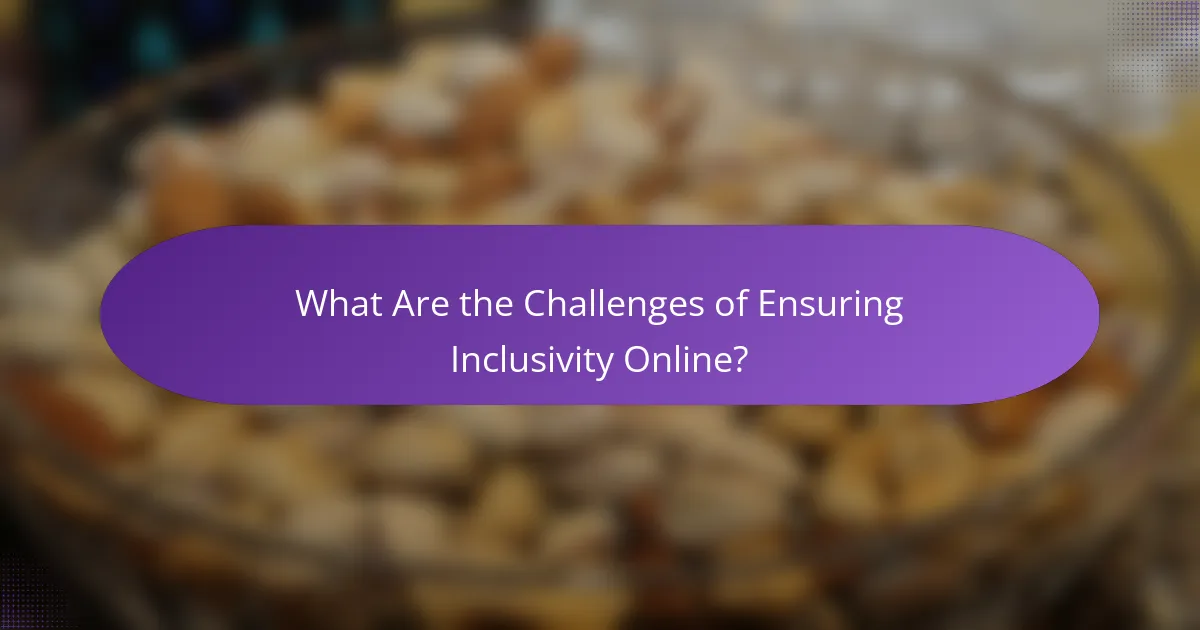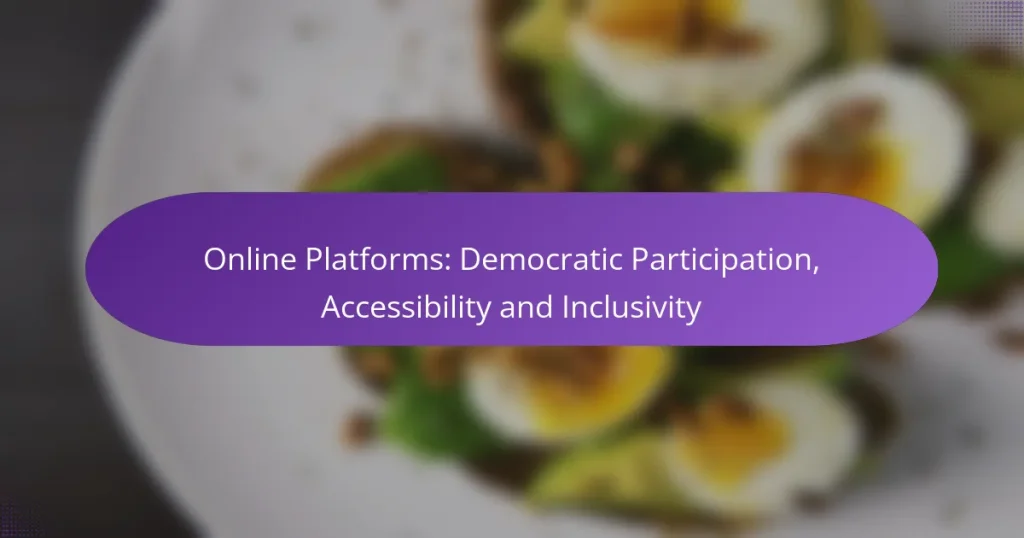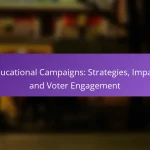Online platforms play a crucial role in fostering democratic participation by offering accessible tools that encourage engagement and dialogue among users. By incorporating essential accessibility features, these platforms ensure inclusivity for individuals with diverse needs, ultimately enriching the democratic process and enabling broader participation in discussions and decision-making.

How Do Online Platforms Enhance Democratic Participation?
Online platforms significantly enhance democratic participation by providing accessible tools for engagement, discussion, and feedback. These platforms facilitate a more inclusive political landscape, allowing individuals to express their views and connect with others in real-time.
Increased voter engagement
Online platforms boost voter engagement by simplifying the process of accessing information about elections, candidates, and voting procedures. Tools such as social media campaigns and dedicated voting apps can increase awareness and motivate individuals to participate in elections.
For example, platforms like Vote.org provide users with essential information about registration deadlines, polling locations, and voting methods, making it easier for citizens to take action.
Access to diverse political views
These platforms allow users to encounter a wide range of political perspectives, fostering informed discussions. By following various political commentators, organizations, and grassroots movements, individuals can gain insights into differing opinions and policy proposals.
For instance, platforms like Reddit and Twitter facilitate conversations among users with diverse viewpoints, helping to break down echo chambers and promote understanding across political divides.
Real-time feedback mechanisms
Real-time feedback mechanisms on online platforms enable citizens to voice their opinions and influence political decisions quickly. Features like polls, surveys, and comment sections allow users to share their thoughts on current issues and proposed legislation.
Governments and organizations can utilize this feedback to gauge public sentiment and adjust their policies accordingly, leading to more responsive governance.
Community-driven initiatives
Online platforms support community-driven initiatives that empower citizens to organize and advocate for change. These initiatives often leverage social media to mobilize support for local causes, campaigns, or events.
For example, platforms like Change.org allow users to create petitions, rallying support around specific issues and encouraging collective action to influence decision-makers.
Case studies of successful platforms
Several online platforms have successfully enhanced democratic participation through innovative approaches. For instance, platforms like Facebook have been used to organize large-scale protests and movements, such as the Arab Spring, demonstrating the power of social media in mobilizing citizens.
Similarly, platforms like Nextdoor have fostered local community engagement by connecting neighbors and facilitating discussions about local governance and initiatives, showcasing the potential of localized online interactions.

What Accessibility Features Are Essential for Inclusivity?
Essential accessibility features for inclusivity include screen reader compatibility, keyboard navigation support, multilingual options, and visual and auditory aids. These elements ensure that online platforms are usable for individuals with diverse needs, enhancing their participation and engagement.
Screen reader compatibility
Screen reader compatibility allows visually impaired users to access content through auditory means. Websites should follow the Web Content Accessibility Guidelines (WCAG) to ensure that all text, images, and interactive elements are properly labeled and can be read aloud by screen readers.
To improve compatibility, use semantic HTML elements like headings, lists, and landmarks. Regularly test your site with popular screen readers such as JAWS or NVDA to identify and fix any issues.
Keyboard navigation support
Keyboard navigation support enables users who cannot use a mouse to navigate websites using keyboard shortcuts. This feature is crucial for individuals with motor disabilities who rely on keyboard commands to interact with online content.
Ensure that all interactive elements are accessible via the Tab key and that focus indicators are visible. Avoid using keyboard traps, where users cannot navigate away from an element, as this can lead to frustration and accessibility barriers.
Multilingual options
Multilingual options allow users to access content in their preferred language, promoting inclusivity for non-native speakers. Providing translations and language-switching capabilities can significantly enhance user experience and engagement.
Consider implementing language tags in your HTML to help search engines and assistive technologies identify the language of your content. Offering a clear language selection menu can also facilitate easier navigation for users.
Visual and auditory aids
Visual and auditory aids enhance the accessibility of online content for users with varying sensory abilities. This includes providing captions for videos, transcripts for audio content, and alternative text for images.
When creating visual content, ensure that color contrast meets accessibility standards to aid users with visual impairments. Additionally, consider incorporating sign language interpretation for video materials to cater to the deaf and hard-of-hearing community.

Which Platforms Lead in Accessibility and Inclusivity?
Several online platforms prioritize accessibility and inclusivity, making strides to accommodate diverse user needs. Facebook, Twitter, Zoom, and Microsoft Teams each implement unique features and practices to enhance user experience for all individuals.
Facebook’s accessibility tools
Facebook offers a variety of accessibility tools designed to support users with different needs. Features like automatic alt text for images help visually impaired users understand visual content, while customizable text size and contrast settings enhance readability for those with visual impairments.
Additionally, Facebook provides options for users to report accessibility issues, allowing the platform to continually improve its services. Users can also utilize closed captioning for videos, ensuring that content is accessible to those who are deaf or hard of hearing.
Twitter’s inclusive design practices
Twitter emphasizes inclusive design by implementing features that cater to various accessibility requirements. The platform supports image descriptions, enabling users to add alt text to their images, which assists visually impaired individuals in understanding the context of shared visuals.
Moreover, Twitter has introduced color contrast adjustments and screen reader compatibility to enhance usability. Users are encouraged to engage with accessibility features, ensuring that tweets are accessible to a wider audience.
Zoom’s accessibility features
Zoom incorporates several accessibility features to facilitate participation for all users. The platform offers closed captioning and live transcription services, which are essential for individuals who are deaf or hard of hearing. Users can also adjust the video layout to suit their preferences, making it easier to follow discussions.
Zoom’s keyboard shortcuts and screen reader compatibility further enhance accessibility, allowing users to navigate the platform efficiently. These features ensure that everyone can engage in virtual meetings without barriers.
Microsoft Teams’ inclusivity initiatives
Microsoft Teams focuses on inclusivity through various initiatives aimed at accommodating diverse user needs. The platform includes features such as live captions and subtitles during meetings, which benefit users with hearing impairments. Additionally, Teams allows for background noise suppression, improving audio clarity for all participants.
Microsoft also provides accessibility training resources for users to learn how to utilize these features effectively. By fostering an inclusive environment, Teams encourages collaboration among users with varying abilities.

How Can Businesses Improve Accessibility on Their Platforms?
Businesses can enhance accessibility on their platforms by adopting inclusive design principles, conducting thorough testing, and ensuring that all users can navigate and interact with their services effectively. This approach not only meets legal requirements but also broadens the customer base and improves user satisfaction.
Conducting user experience testing
User experience testing is crucial for identifying barriers that may hinder accessibility. By involving individuals with diverse abilities in testing sessions, businesses can gain valuable insights into how their platforms perform in real-world scenarios.
Consider using methods such as remote testing and in-person usability sessions to gather feedback. Aim for a diverse group of testers, including those with visual, auditory, and motor impairments, to ensure comprehensive evaluation.
Implementing accessibility audits
Accessibility audits help businesses assess their platforms against established standards like the Web Content Accessibility Guidelines (WCAG). These audits can reveal specific areas needing improvement, such as color contrast, text size, and keyboard navigation.
Conduct audits regularly, ideally every six months, to keep up with updates and changes in technology. Utilize both automated tools and manual reviews to ensure thoroughness, and prioritize fixes based on user impact.
Training staff on inclusivity
Training staff on inclusivity is essential for fostering a culture that values accessibility. Employees should understand the importance of inclusive design and how to implement it in their daily tasks.
Consider offering workshops and resources that cover topics such as universal design principles, assistive technologies, and the legal implications of accessibility. Regular training sessions can help keep the team informed about best practices and emerging trends in accessibility.

What Are the Challenges of Ensuring Inclusivity Online?
Ensuring inclusivity online faces several challenges, including technological barriers, a lack of awareness among developers, and socioeconomic disparities. These obstacles can hinder equal access and participation for all users, particularly marginalized groups.
Technological barriers
Technological barriers refer to the limitations of devices, software, and internet access that can prevent users from engaging fully with online platforms. For instance, individuals with disabilities may find it difficult to navigate websites that are not designed with accessibility in mind, such as those lacking screen reader compatibility.
Moreover, inconsistent internet speeds and availability can disproportionately affect users in rural or economically disadvantaged areas. Websites that require high bandwidth or advanced technology may alienate these users, further widening the digital divide.
Lack of awareness among developers
A significant challenge to online inclusivity is the lack of awareness among developers regarding accessibility standards and best practices. Many developers may not prioritize inclusivity during the design and development phases, leading to platforms that are not user-friendly for everyone.
To combat this, it is essential for developers to engage in training and education on inclusive design principles. Incorporating user feedback from diverse demographics can also help identify and rectify accessibility issues early in the development process.
Socioeconomic disparities
Socioeconomic disparities play a crucial role in determining who can access online platforms and participate in digital spaces. Individuals from lower-income backgrounds may lack the necessary resources, such as reliable internet access or modern devices, to engage fully with online content.
Additionally, education levels can impact digital literacy, making it challenging for some users to navigate complex online systems. Addressing these disparities requires targeted initiatives, such as community programs that provide training and resources to underserved populations.


